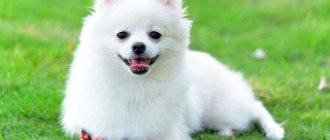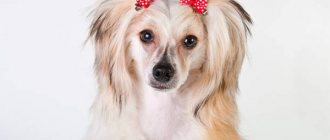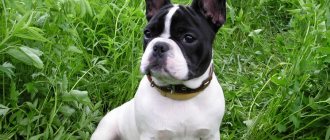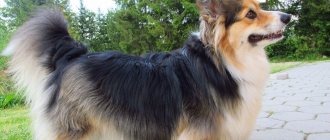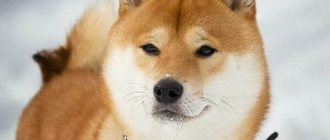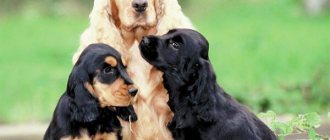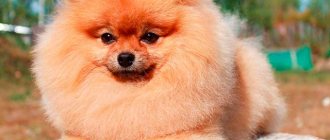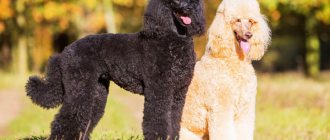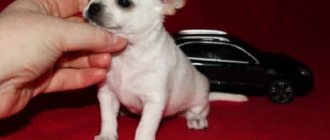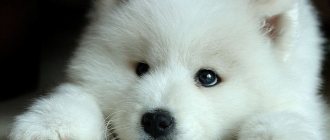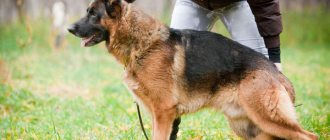Breed traits
Breed traits (on a 5-point scale)
| Miniature Poodle (Miniature Poodle) | |||
| Activity | in the house | 3.2 | |
| on the street | 3.3 | ||
| Obedience | training | 4 | |
| strangers | 4 | ||
| Domination | in family | 2 | |
| over dogs | 2.6 | ||
| Defending your territory | from people | 3 | |
| from dogs | 3 | ||
| Sociability | in family | 4.8 | |
| with strangers | 3.7 | ||
| with dogs | 3 | ||
| Concentration | in family | 1 | |
| in front of strangers | 1.8 | ||
| with dogs | 1.5 | ||
| Aggressiveness | in family | 1.2 | |
| to strangers | 1.4 | ||
| to the dogs | 2 | ||
| to cats | 2 | ||
| Family behavior | calmness | 4.5 | |
| demand for affection | 5 | ||
| excitability | 4.2 | ||
| playfulness | 4.6 | ||
| excessive barking | 2.7 | ||
| behavioral breakdowns | 1.5 | ||
| Tolerance for children | up to 4 years | 4 | |
| over 4 years old | 4 | ||
| Institutional use | watchman | 4 | |
| bodyguard | 2 | ||
This breed is often compared to the following dog breeds: Yorkshire Terrier, English Cocker Spaniel, Maltese (Maltese Bichon), Bichon Frize, Finnish Spitz.
The photo shows what miniature poodles look like:
Description and features
The Miniature Poodle breed is the smallest of all poodles. She was bred from a larger representative of the breed (the Great Royal). It differs from other brethren not only in its miniature size, but also in the presence of a fluffy curly coat.
It is believed that the dog was born in the 40s of the 19th century. The main breeder of this breed was a Swiss named Shaitlin. Even then he claimed that he had created perfection. In his opinion, the baby poodle is the most loyal, intelligent and noble in comparison with all known dog breeds.
This dog has a huge amount of talent! For example, due to his amazing artistry, he is trained by circus trainers to perform in the arena. The kid loves it when hundreds of people look at him and applaud. For their sake, he is ready to study and train a lot. Even the most difficult tricks will not scare him. Loves attention from the crowd!
Miniature Poodles are easy to train and perform well.
This amazing and kind dog is suitable for almost everyone. Suitable for indoor use, does not cause many difficulties in care. He sincerely loves people and does not seek to create problems for them. He will get along with a pensioner, a schoolchild and even a formidable hunter. She is ready to share her life with someone who will open up to her and begin to patronize her.
The main feature of the animal is its impressive appearance. It is often started to impress others or to show off to neighbors. But you shouldn't do that! Remember, a pet is a living creature that needs your care and love. By buying it, you accept responsibility for its life and health.
The dog is perfect for those who like to attend show exhibitions. With high-quality representatives of this breed, you will be welcomed at any animal event. He will be registered as a participant without any problems. It is possible that it will take a prize place and generate income.
Of course, the animal will never understand the value of money, but will try to win in order to win as many human hearts as possible. Yes, it just loves attention. Despite their kindness and balance, toy poodles have aristocracy and grace. Their gait is cheerful and at the same time majestic, and their gaze is friendly and inspiring respect.
Poodles were previously used for hunting
General characteristics of the breed
Poodles are a popular and well-recognized breed all over the world. They perform in the circus and perform complex stunts. These dogs are very smart, quick-witted, love to learn and serve people. But their main feature is their original appearance. Dogs of this breed have fluffy long hair and they have different haircuts.
Now the poodle breed is known in four varieties: standard, medium, miniature and toy. They differ in height and weight. The miniature or miniature poodle is the most popular option for keeping at home. This is a cheerful, playful and very smart pet. He gets attached to his owners and is good with children. These dogs are smaller in size than the medium or small poodle, and differ from the toy in better health and endurance.
| Options | Characteristic |
| breed name | toy or miniature poodle |
| country of origin | France |
| year of registration | 1840 |
| group of breeds according to the ICF classification | decorative and companion dogs, poodle section |
| usage | companion, circus dog |
| life expectancy | 12-15 years |
| height | 28-35 cm |
| weight | 4-7 kg |
| aggressiveness | not aggressive, friendly with everyone |
| activity | active, mobile |
| intelligence | tall, easy to train |
| care | complex grooming |
| health | weak |
pros
Dwarf poodles were not always popular, unlike their royal ancestors. But recently interest in them has increased. This is due to the extraordinary appearance of these dogs and their high intelligence. In the ranking of the smartest dogs compiled by Dr. Coren, poodles take 2nd place. They have several more advantages:
- due to their small size, they easily get along in a small apartment;
- suitable as a first pet, not prone to dominance;
- they are easy to learn, even children can train them, they quickly learn commands;
- very artistic, easily learn tricks, can perform in the circus, participate in dog sports;
- cheerful, cheerful, good-natured, peaceful;
- sensitive, understand the owner’s mood, easily adapt to his habits;
- get along well with children and other pets;
- almost do not shed, do not have a dog smell, so they are suitable for people with allergies;
- with proper care, these dogs live a long time;
- complete absence of aggression.
Minuses
Don’t think that because of its attractive appearance it will be an indoor toy dog. The poodle has character, it is a serious dog. His ancestors were hunting gun dogs and worked as rescuers and watchmen. Therefore, the breed is not suitable for those who need a decorative dog, it is more of a companion. There are a few other downsides that can create maintenance problems.
- Difficult coat care. It needs to be combed and trimmed regularly. You will have to buy tools and learn the rules of cutting or visit a hairdresser.
- This is a very active, inquisitive pet. He needs to be walked for at least 2 hours a day. When walking with your pet, you need to exercise: run, play, train.
- If you don't give your dog attention and don't give him an outlet for energy, he can become nervous and irritable. These poodles behave restlessly.
- Representatives of the breed are very emotional and express their emotions with their voice. Their bark is loud, which can create problems in an apartment building.
- Poodles do not tolerate change well; they do not like noise or a nervous environment in the house. They become very attached to their owner and cannot get used to the new owner.
- These dogs need attention. When alone, they feel sad and can become depressed.
pros
Buying a dog is a responsible step. You must familiarize yourself with all the breed characteristics and weigh the pros and cons. First, let's look at the advantages of the breed:
- Intelligence : Poodles rank second among the ten smartest dog breeds in the world.
- Obedience : the authority of the owner for the poodle is unshakable.
- Do not shed : Poodle hair does not settle on clothes, furniture and carpets.
- Health : strong immunity and endurance make poodles long-lived.
History of the origin of the Miniature Poodle breed
Dwarf representatives of the breed were bred only in the 19th century, although large poodles have been known since ancient times. These dogs helped people hunt, they were used in patrol and search service, and in war. But gradually, due to their attractive appearance, they increasingly began to be kept as a decorative pet. They became popular among rich people.
But the standard poodle is too tall, so breeders developed a dwarf version of the breed. The emphasis was not on working qualities, but on appearance. The mini-version was bred by the Swiss scientist Shaitlin. The first breed standard was approved in France in 1880.
This variety became popular only in the 20th century. Although during the Second World War, interest in dwarf dogs faded. But in the 60s, breeders began breeding again, and at that time representatives of the breed appeared in Russia. Nowadays, toy poodles are one of the most popular decorative dogs.
History of appearance
Poodle-shaped dogs have been known to man since ancient times: this fact is confirmed by numerous archaeological finds dating back to the 12th-13th centuries.
Dogs with an elongated muzzle and a curly head were depicted on coins in Rome and Greece, written on the walls of the Cathedral in Reims and on the columns of the Montreal Monastery. Reference! The first official description of the poodle was made by Konrad Gesner in 1555, and 7 years later, Gunrat Forer described all three varieties of the breed: dwarf, large and multi-colored.
The history of the origin of the royal poodle in its modern form remains not entirely clear to this day. The most common version says that he appeared as a result of crossing a German “sheep” poodle and a Spanish “water dog”.
Initially, these individuals were used for duck hunting. The slender body and thick hair allowed the dog to swim quickly and, in general, feel comfortable in the water.
It is believed that the name poodle comes from the German verb “paddeln” - “to splash” or from “pfundelhund” - “waterfowl dog”. The poodle, despite its “glamorous” and pampered appearance, loves to swim in the water, and if its owner allows it, it will happily dive into a pool or pond to frolic.
Description of appearance
The miniature poodle is a smaller copy of the standard representative of the breed. He has retained all the proportions of his body, and unlike toys, they do not have signs of dwarfism. The height of an adult miniature is 28-35 cm. The dog weighs 4-7 kg. Deviations from these parameters are not recognized by the standard and apply to other varieties of poodles.
Puppies grow until they are about 6-7 months old. At this age you can understand whether the dog will meet the standard. Then they gain a little height and weight, reaching their maximum weight by the age of one year.
Head
The head is of the correct shape, proportional to the body. The occipital protuberance is moderately pronounced, the stop is smooth. A feature of the breed is a longitudinal groove that runs from the back of the head to the back of the nose. The muzzle is elongated, but not narrow. The jaws are well developed, fit tightly together, and have a scissor bite. The teeth are strong, pure white in young dogs, but may darken with age.
The nose is medium, the nostrils are wide. Black in color; in red and apricot dogs it can be brown. The eyes are almond-shaped and slightly oblique. Amber or brown depending on coat color. The ears are wide, soft, hanging. They fit to the head, the lower edge reaches the lips.
Frame
This dog has a strong, harmonious build. Unlike Toy, they have no grace. The body format is rectangular - the length is greater than the height at the withers. The neck is of medium thickness, the scruff is well defined. The chest is wide, reaching the elbow joints. The abdomen is moderately tucked. The back is short and straight, tapering towards the loin, the croup is rounded.
The tail is without bends, set high. It does not fall over the back, but when the dog moves, it lifts it, it takes on a saber shape. Some breeders dock the tip of the tail, but it should not be very short.
Limbs
The limbs are straight, muscular, but not wide. Placed in parallel. The hock joints are well defined. The paws are small, the toes are compactly collected. The gait is light and springy.
Coat and colors
The hair of dwarf poodles is thick and fluffy, similar in structure to human hair, without undercoat. It can be of two types. The first is more common - these are soft, wavy hairs. The wool is voluminous and springy to the touch. The second type is corded. Wool consists of long twisted cords. It is tougher and denser.
The color of the poodle should be uniform, without spots or inclusions of other colors. It is fully formed only by the age of 12 months. In an adult dog, color saturation or hue may change. The standard provides several color options:
- black;
- white;
- brown;
- red in different shades - apricot, peach, red;
- grey.
Rare colors not recognized by the FCI are harlequin and tan. These dogs are bred in Russia. Harlequin is a white dog with a black head and a blanket on his back. Tan dogs may have a background color of black, red, brown or grey. 20% of the body is occupied by fur of a different color, usually on the chest, muzzle, and paws.
Photos complement the description of the appearance of these dogs:
Adult dog diet
Like other breeds, the Royal Poodle can eat a natural or dry diet.
The first option is suitable for experienced breeders, since when drawing up a natural menu, it is necessary to take into account not only the list of permitted and prohibited foods, but also calculate the KBZHU so that the dog has enough all the nutrients.
Premium and holistic dry food is the ideal balance of simplicity and benefit. You should not mix natural products with dry food.
Reference! Find out what the breeder fed the puppies and stick to the same menu for the next two weeks. A sudden change in diet is stressful for the puppy, and, as a result, digestive problems.
How to feed?
The basic rules for feeding royal poodles are as follows:
- The food plate should be located at chest level. Buy a bowl on a stand with an adjustable height and add a few centimeters as your puppy grows.
- Feed your dog on a schedule : pour food at the same time. If your dog leaves food in the bowl, remove it until the next feeding.
- Do not give your dog treats from the table : firstly, this is fraught with poisoning, allergies or indigestion. Secondly, this will lead to the dog constantly begging and looking for treats outside the bowl, and given the dog’s intelligence, it will not be difficult for him to find where you hide cookies or candy.
- Feed the animals separately : if you have two or more dogs at home, place their bowls at a distance, or better yet, in different rooms.
- Provide access to clean water : Make sure your dog always has fresh drinking water in his bowl.
Character and education of Miniature Poodle dogs
The character of this dog combines aristocracy and restlessness. Unlike royal poodles, dwarf poodles are more mobile and active. This is a cheerful, playful animal that treats everyone kindly. The dog becomes attached to the owner and his family members, loves children, can be wary of strangers, but does not show aggression.
This breed is suitable for both single people and large families with school-age children; young people and old people find a common language with it. All poodles are empaths, they feel the mood and psychological state of the owner, and are always ready to calm and cheer. If a person is not predisposed to communication, the dog will not impose itself. These pets easily adapt to the owner’s lifestyle and can adopt his habits and repeat his behavior.
Another important feature of the character of a dwarf poodle is that it needs constant communication with a person. These dogs love to be the center of attention, they like to be praised and petted. Therefore, poodles are happy to perform in various shows and in the circus. These are inquisitive, cheerful dogs, they never sit still, follow their owner’s heels, and participate in all activities.
Negative character traits include excitability, jealousy and vulnerability. This distinguishes dwarfs from large poodles. They are very sensitive, emotional and impressionable. They bark loudly from excess feelings. They do not tolerate rudeness well and do not tolerate being shouted at. These dogs can be unbalanced, irritable, and fearful. They are highly susceptible to stress.
Dog experts do not recommend having a miniature poodle for families with small children. Due to its small size, this pet is fragile and a child can hurt it. In response to this attitude, the dog may develop mental problems.
Features of training
The Miniature Poodle is one breed that is suitable for inexperienced owners. These are very smart, obedient dogs, they love to learn and quickly learn commands. Therefore, even a child can train them. The main thing is to follow a few rules:
- Early socialization is important for a puppy, without which he can grow up fearful and aggressive;
- You can’t behave rudely, shout at the dog, it will withdraw and stop obeying;
- Encouragement and affection are required;
- training should take place in the form of a game; poodles need new experiences.
Sometimes dog handlers recommend building the training process like a circus performance. Let someone watch the dog, clap and admire. Poodles love this very much.
How to walk with him?
Active games outside are a favorite pastime for the Royal Poodle. However, given the climatic conditions of our country, it is worth taking care of clothing in advance.
And the point is not even that the poodle will freeze - he will get dirty. Imagine a fluffy and snow-white puppy like a cloud, who runs with delight to plop down in a dirty puddle with gasoline stains. The spectacle is not for the faint of heart.
And even worse are the consequences. You, as the owner, will have to spend more than one hour to get the mess in order.
This can be avoided by using special demi-season clothing - waterproof raincoats, raincoats and boots.
Reference! Sew reflective tape to your pet's jacket - this will protect him if he accidentally ends up on the roadway.
For a full-fledged life and comfort for a poodle, two walks of 30-60 minutes are enough: during this time the dog will have time to relieve itself, socialize and play enough with its playmates.
Maintenance and care
Dwarf poodles are unpretentious and adapt to any conditions. You need to provide your pet with a place in the house to sleep and eat. It is recommended to buy a lot of different toys so that the dog does not get bored in the absence of the owner. Despite its compact size and the ability to train it to go to the toilet in a diaper, this dog must be walked 2 times a day. She needs active games and new experiences.
Hygiene procedures for caring for a poodle are the same as for other dogs. It is necessary to regularly examine and clean the eyes, ears, trim the nails and brush the teeth. It is not recommended to bathe your pet often; 1-2 times a month is enough. Be sure to use a special hypoallergenic shampoo. Wash your paws and belly every time after a walk. You need to brush your pet several times a week, this will help prevent tangles and ensure an attractive appearance.
A haircut
The peculiarity of caring for a poodle's coat is that it needs to be cut. It is recommended to do this once every 1-2 months. Grooming will help prevent the dog's fur from becoming matted and overheating in hot weather. Removing hair on the paws, belly, and under the tail makes it easier to maintain cleanliness. If the poodle is being exhibited, it is better to visit a hairdresser. But many owners give their pets their own haircuts; to do this, they need to purchase special scissors and a clipper.
When choosing, you need to make sure that the tools are designed for poodles. Due to the nature of the coat, standard clippers are not suitable for wire-haired dogs. You will need long and short scissors. The blades should have small notches; they prevent the hair from slipping out and make the haircut smoother.
The standard allows several types of hairstyles for a poodle: lion, English, modern and bikini. But if the dog will not be shown, you can cut it however you like. There are different exotic options that give the poodle an original look.
Photos of different haircuts for miniature poodles:
Nutrition
The dwarf poodle is unpretentious in food. You can feed him prepared food or natural food. Just don’t mix these two types of food. Ready-made food includes not only dry granules, but also canned food; they must be of the same brand.
For dogs of this breed, super-premium or holistic options are suitable. They contain a balanced amount of microelements, proteins, fats and carbohydrates, and do not contain grains or synthetic additives. The best dry food for a miniature poodle: Acana, Farmina Natural&Delicious, Grandorf, Almo Nature, Brit Care, 1-st CHOICE.
With natural feeding, you need to properly formulate the diet so that the pet gets everything it needs. It should consist of the following products:
- meat – beef, turkey, rabbit;
- offal;
- 1-2 times a week sea fish;
- 1-2 eggs per week;
- porridge – buckwheat, oatmeal, rice;
- fresh and boiled vegetables except potatoes;
- dairy products;
- greenery.
You should not give your pet legumes, pork, smoked meats, sweets, or baked goods. Fried and spicy foods, confectionery, and food from the human table are prohibited. You cannot overfeed a poodle; representatives of the breed are prone to obesity. An adult dog needs to be fed 2 times a day: morning and evening. On the recommendation of a veterinarian, you can add multivitamins, fish oil, and bone meal to your food.
Health
The dwarf varieties of many breeds have poor health. Mini poodles are no exception. The owner needs to pay close attention to the proper nutrition and maintenance of the pet. Visit the veterinarian at least twice a year for preventive examinations. Be sure to get all necessary vaccinations to protect against infections. Every 3-4 months the dog needs to be treated for parasites. Then the pet will live a long time and remain active until old age. Some representatives of the breed live up to 18-20 years.
A healthy dog will be active and playful, have a good appetite and a good mood. The eyes are clear, the coat is thick and shiny. The nose should be wet and cold. If your dog refuses to eat, becomes sad or aggressive, it is recommended to visit a veterinarian.
If not properly cared for, the poodle may develop allergies and gastrointestinal diseases. They are prone to weight gain, dermatitis, and inflammatory diseases of the eyes and ears. They have the following pathologies:
- diabetes;
- epilepsy;
- cataract, glaucoma;
- intervertebral hernia;
- lymphadenitis;
- hypothyroidism;
- oncological diseases.
Common diseases
Royal Poodles are prone to the following diseases:
- disorders of the gastrointestinal tract: bloating, volvulus, gases;
- epilepsy;
- hip dysplasia;
- hypothyroidism;
- diabetes;
- intervertebral disc disease;
- lymphadenitis;
- degenerative myelopathy;
- insulinoma;
- von Willebrand disease;
- progressive retinal degeneration;
- cataract;
- glaucoma;
- baldness;
- ear infection;
- urolithiasis disease;
- allergy.
Important! Visit your veterinarian at least once every six months for a preventive examination. This will help you protect your pet from unwanted diseases.
How to buy a purebred puppy
Buying a purebred dwarf poodle is not a problem, the breed is now popular. But it is better to contact a nursery or a reputable breeder. When choosing a puppy, be sure to study the documents of the parents and the living conditions of the animals. Babies must have all vaccinations required by age, a puppy card and a veterinary passport.
The gender of the dog should be chosen depending on the purpose of purchase. A male dog is more suitable for exhibitions. Boys are more beautiful and resilient. Bitches are affectionate, obedient and calm. Prices for dogs depend on the class. On average they start from 15 thousand rubles. But a show class dog costs 50 thousand and above.
The puppy should be active, playful, and not cowardly. By 2 months of age, when poodles are sold, they should exhibit the basic characteristics of the breed. A healthy puppy has soft shiny fur without bald spots, clean, clear eyes, and a soft tummy.
The photo shows what the puppies look like:
An interesting video about a miniature poodle will help you understand whether this breed is worth getting:
Video: The Miniature Poodle is a delightfully smart dog!
Video: All about the poodle. Pros and cons of a miniature poodle
The Miniature Poodle is an amazing dog, smart, obedient and beautiful. She will become the best friend of any person who is ready to pay attention to her.
Large Royal Poodle puppies
It is better to buy a puppy from a good nursery. This will guarantee that the dog will be purebred and healthy. The price of such a puppy in Moscow ranges from 20 to 60 thousand rubles. Show class specimens are even more expensive. You can buy it on the market or through advertisements for 10-15 thousand. But this is often the case for the sale of mestizos, animals with hereditary diseases or breed defects.
When choosing a dog, you need to visit the nursery, study the conditions of keeping the animals and documents. The puppy should be cheerful, active, not cowardly or aggressive. The following signs indicate health:
- the coat is fluffy, soft, without dandruff;
- skin without rash or irritation;
- ears and eyes are clean;
- There is no unpleasant odor coming from the baby.
Photos of Royal Poodle puppies:
An interesting video will complement the information about dogs of the large poodle breed:
Video: Royal Poodle
Video: Royal Poodle - Interesting facts about the breed
Video: Poodles are one of the smartest dogs. About the breed
The Royal Poodle is an ideal pet for families with children or for single people. These dogs get along well with people of any age. They will be obedient, devoted, and fill life with joy. The main thing is to give them enough attention and love.
Reproduction and lifespan
The miniature poodle has joined the ranks of long-lived dogs. With proper nutrition and good care, he will live at least 15-16 years. The breeder must be able to distinguish a miniature poodle from a toy. They are very similar, but still different. It is advisable to breed individuals of the same breed species. It is important that they are not related to each other, since in this case they will not have to wait for healthy offspring.
It is necessary to count the date favorable for conceiving offspring and take the bitch to the male on the 3rd day of her heat. She gives birth to from 1 to 6 puppies. Childbirth can be complicated, so when she starts having contractions, we recommend calling a veterinarian.
Possible diseases and methods of treating them
Unfortunately, representatives of this breed are sickly. Doctors discover cataracts or otitis media in almost every poodle at the end of its life. Genetically, such dogs are predisposed to many eye and ear diseases. They cannot be treated without professional help.
Also common among them are: hip dysplasia, osteochondrosis, diabetes mellitus and other diseases. In dogs that suffer from ailments of the joints and muscles, coordination of movements is impaired. They should not be exhausted by stress; it is better to create comfortable conditions for home rest.
But those who are faced with diabetes or allergies will have to follow a diet. Less commonly, toy poodles are diagnosed with cancer. If malignant tumors are detected early on the surface of dog organs, it is possible to save them in an operable manner.
Buying a puppy, price
In Russia and many other countries there are nurseries and breeders that specialize in breeding poodles of non-standard colors, based on compatibility. The main stock in their kennels are usually standard solid colored poodles. It is undesirable to breed harlequins and phantoms with each other, this leads to degeneration of the desired characteristics.
- Harlequins are born by crossing white poodles with dark skin and black or silver poodles that carry the spotting gene.
- Phantoms are born from mating apricot or red poodles with black ones.
Price
On Internet message boards, phantom and harlequin poodles do not appear as often as poodles of recognized solid colors. Their cost depends on pedigree, correct color, and other breed characteristics. The average price is 25,000 rubles.
Popular colors of toy poodles
The coat of the toy poodle is curly, thick, with fine guard hairs. The hairs themselves are quite elastic and resist being compressed. There are also individuals with coarser corded fur. There is no undercoat, and there is no dog smell either. Toy poodles do not actively shed and their fur does not cause allergies.
The Toy Poodle comes in a wide variety of colors. Only six options have been officially approved (according to the standard), but in reality there are many more. After all, when crossing dogs with different coat colors, the color of the offspring can turn out to be the most unpredictable. Yes, such dogs will not be allowed to show, but in all other respects they will be quite decorative and cute.
Dogs of the Toy Poodle breed have the following colors:
- White. The most common and popular color today. The toy poodle with white fur looks very noble. Puppies may have a faint cream or apricot tint to their coat, which fades over time. The skin of a white dog is usually pink, less often spotted. The nose and claws are black, the eyes are brown;
- Black. Classic color. In this case, the color of the coat should be extremely even, without spots of other colors or a reddish tint. Paw pads, claws, nose - only black, without any multi-colored spots. Skin - gray or blue;
- Brown (chocolate). The coat has a uniform, rich brown color without spots. The fur on the ears is a little lighter. The nose is brown, the eyes are amber or brown;
- Silver. The coat is an even silver-gray color. It is interesting that this color is formed only by 2-3 years of a dog’s life, because puppies are born with black hair. However, according to some signs, dog lovers can identify silver color starting from six weeks. At the same time, the eyelids, nose, lips are black, and the eyes are dark brown, almost black;
- Red (mahogany). Coat color is dark red. Nose, eyelids, lips - brown or black;
- Apricot. All apricot shades are allowed - from dark to light. As a dog ages, its coat becomes lighter in color. Very old dogs have a cream colored coat. Skin color is pink, much less often blue. The color of the eyelids, nose and lips is black or brown.
In 2007, two more colors were added to the Toy Poodle breed standard - white and black (harlequin) and black with tan (markings) of any color.

